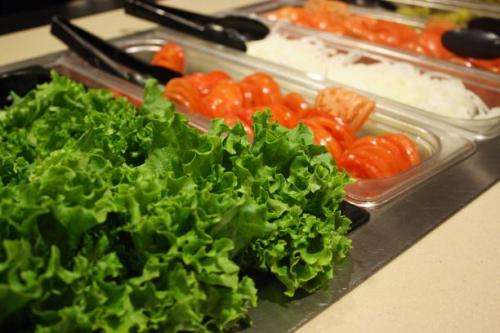The U.S. and Mexico are dependent upon each other when it comes to food production, processing and transportation. Credit: Beatriz Verdugo/UANews
(Medical Xpress)—The U.S.-Mexico border is the border in the world with the greatest disparity in access to food and water needed for human survival, according to a report commissioned and published by the Southwest Center at the University of Arizona.
An endowment from the Kellogg Foundation and a UA Confluencenter for Creative Inquiry grant supported the study and its focus on assessing transborder food systems to understand water scarcity and food insecurity within the borderlands region.
The report underscores how in the globalized economy, Arizona and the rest of the United States rely on the skilled labor, water, fresh produce, fish, shellfish and livestock originating in northern Mexico; while in Mexico, the population is increasingly dependent upon frozen and processed foods originating in the United States.
Yet, according to the researchers, the food and water security policies of these two nations seldom factor in how natural or manmade disruptions in the production, processing and transport of food from one side of the border effects the health and vulnerability to hunger of millions of people on the other side of the boundary.
The 65-page report, "Hungry for Change: Borderlands Food and Water in the Balance," was released in August to stimulate civil public discourse in advance of the Border Food Summit to be held Sept. 16-18 at the Esplendor Resort in Rio Rico, Ariz.
From agricultural fields, border crossings, canning kitchens, community-food projects, produce-brokerage houses, ranchlands, road-side stands, school garden soup kitchens, taco wagons, truck stops and Walmarts, the report "daylights" the many faces and voices in the food chain.
The report includes contributors, 16 in all, recruited from non-profit agencies or research centers in Sonora, Mexico, Nicaragua, New Mexico, Texas, California, Colorado, Oregon and Minnesota with the input from six departments at the UA and other Tucson-based organizations. The contributors captured the perspectives of consumers, farmers, ranchers, fishermen, aquaculturists, teachers, truckers, community-health workers and customs agents in the seven U.S. and Mexican border states.
Gary Nabhan, the W.K. Kellogg Foundation Endowed Chair in Southwest Borderlands Food and Water Security at the UA's Southwest Center, said, "The principal focus of the publication is how the Greater Sonoran Desert functions as a single binational, multi-cultural foodshed, in how it feeds some populations while others are placed at risk. There is no simple correlation between how much food a border state produces and how many of its children escape poverty and hunger – that's why we wanted to look at the problems as well as the grassroots solutions developing at every point in the food chain."
Nabhan said the report includes important contributions to the understanding of the impact of a recent drought hitting all northern Mexican states, the impact of the February 2011 freezes on fresh produce and wild food resources, and the entangled politics of free-trade, transnational grocery chains and transboundary water flows.
Reflecting on several years of research in the Mexican countryside and the flow of foods into packing and brokers' shipping houses in Nogales, Ariz., Jeffrey M. Banister, assistant research social scientist at the Southwest Center and the school of geography and development, said, "It is nearly impossible to talk about agricultural production and consumption in either Mexico or the United States as an isolated or discrete processes. Our need to eat ties us together, just as it does environments and the forces shaping them. The result of our research, the 'Hungry for Change' report, challenges the borders – political, cultural, economic – that impede food security and provides a richly detailed analysis of their effects on our ability to eat well."
Among the new findings found in "Hungry for Change" are:
- Enormous quantities of food flow both ways across the border, and considerable quantities of fresh water and fossil fuel are embedded in every bite eaten by desert dwellers in both countries.
- Roughly 60 percent of all fresh produce eaten in the U.S. during the winter and spring months is grown in northern Mexico, but its production and transportation can be easily disrupted by climatic disasters, by social conflicts or by policy shifts.
- While per capita income in the U.S. is 5.6 times greater than that in Mexico, these national trends do not reflect realities closer to the border. U.S. border counties suffer poverty levels twice as high as the country as a whole and income in Mexico's border states is 75 percent higher in the Republic as a whole.
- Mexico's food economy has become increasingly dominated by big-box grocery chains owned or franchised by American corporations, and the nutritional, cultural and economic consequences of this shift are being hotly debated.
Provided by University of Arizona





















